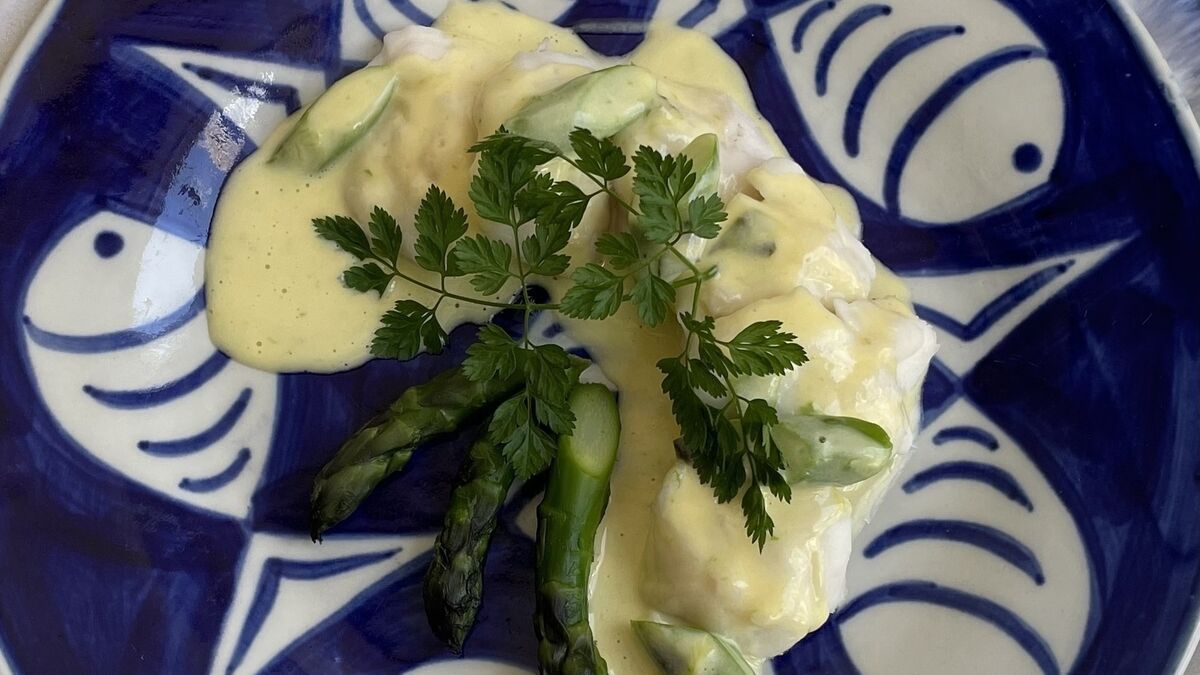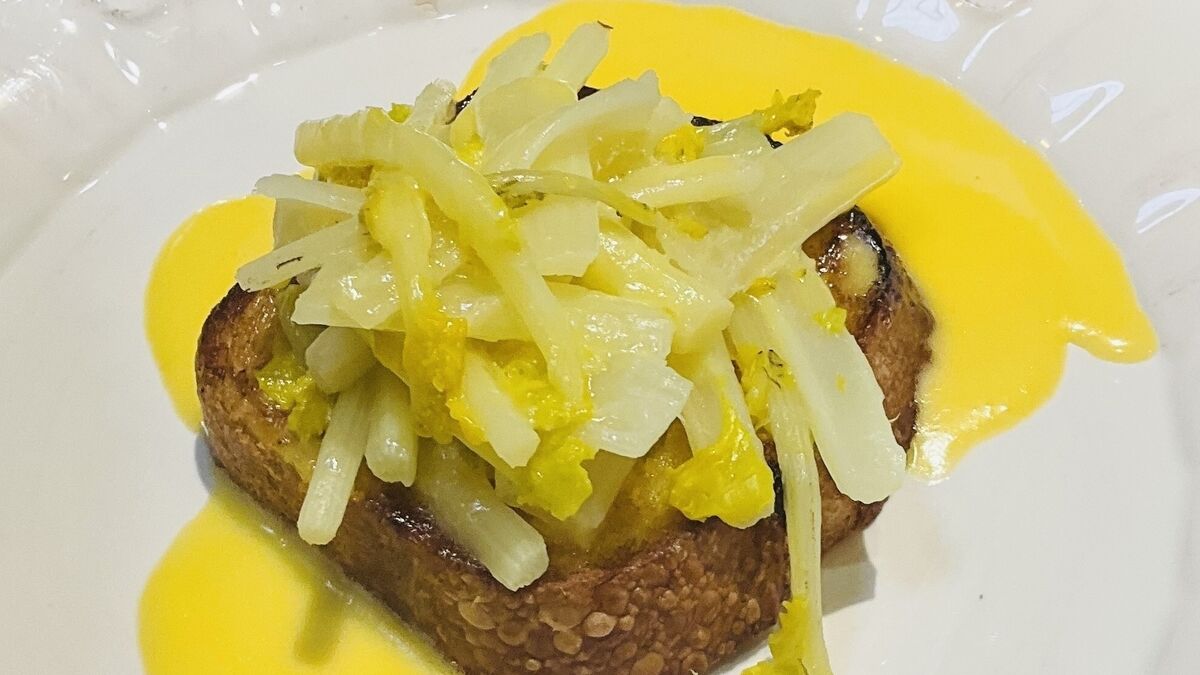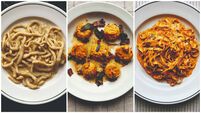Darina Allen: How to make the most popular monkfish dish in our restaurant
Try this new recipe for monkfish cheeks with asparagus and butter sauce.
It's a super exciting time of the year for cooks and gardeners. The hungry gap is almost over. We’ve been rewarded with a bumper garden rhubarb harvest this year after we piled on a generous mulch of compost last autumn.
Poached Monkfish Cheeks with Asparagus Butter
This is by far the most popular monkfish dish in our restaurant. Serve it sparingly for a special occasion and don’t compromise the recipe.

Servings
6Preparation Time
5 minsCooking Time
15 minsTotal Time
20 minsCourse
MainIngredients
675g fresh monkfish cheeks
1.2 litres water
1 tsp salt
For the asparagus butter
6-12 spears of asparagus, depending on length
150g butter (preferably unsalted)
225ml cream
sprigs of chervil, to garnish
Method
Trim the monkfish cheeks if necessary Sprinkle lightly with salt and refrigerate until needed.
To prepare and cook the asparagus, hold each spear of over your index finger down near the root end, it will snap at the point where it begins to get tough (use the woody ends for asparagus stock for soup). Some people like to peel the asparagus, but we rarely do.
Tie similar-sized asparagus in bundles with raffia. Choose a tall saucepan (one can buy specially designed asparagus pots with baskets). Alternatively, cook in 2.5cm of boiling salted water (1 teaspoon salt to every 600ml) in an oval cast-iron casserole. It’s really easy to overcook because it will go on cooking after removed from the heat. Cook for 3-4 minutes until al dente, or until a knife will pierce the root end easily, and drain.
Put the cream into a heavy-bottomed saucepan and gently reduce to about 3 tablespoons or until it is in danger of burning, then whisk in the butter bit by bit as though you were making a Hollandaise sauce.
Trim off the tips of the asparagus, then slice the stalks. Gently fold both into the butter. If necessary, thin the sauce with a splash of the warm asparagus cooking water and keep warm.
Bring the water to the boil and add the salt. Add the monkfish cheeks and simmer for 4-5 minutes or until completely white and no longer opaque. Drain well.
Arrange in a warm serving dish or on individual plates. Coat the monkfish cheeks with the asparagus butter. Garnish with sprigs of chervil and serve immediately.
Myrtle’s Almond Tart with Rhubarb & Strawberries
This was one of the first recipes I learned from Myrtle when I came to Ballymaloe House in the late 1960’s – still a top favourite.

Servings
12Preparation Time
15 minsCooking Time
60 minsTotal Time
1 hours 15 minsCourse
BakingIngredients
110g soft butter
110g caster sugar
110g ground almonds
300ml whipped cream
For the filling
900g garden rhubarb
200-250g sugar
early Irish strawberries (or raspberries in season)
Redcurrant glaze (optional)
sweet cicely, to garnish
2 x 18cm sandwich tins or 24 tartlet tins
For the redcurrant glaze
350g redcurrant jelly
1 tbsp water approx. (optional)
Method
Preheat the oven to 180°C/Gas Mark 4.
Cream the butter and sugar together, stir in the ground almonds together.
Divide the mixture between the two tins. Bake in the pre-heated oven for 20-30 minutes approx., or until golden brown.
The tarts will be too soft to turn out immediately, so cool for about 5 minutes before removing from tins.
Do not allow to set hard or the butter will solidify, and they will stick to the tins.
If this happens, pop the tins back into the oven for a few minutes so the butter melts, they will then come out easily. Allow to cool on a wire rack.
To make the rhubarb, preheat the oven to 200˚C/Gas Mark 6.
Wipe the rhubarb but do not peel, slice into 2 1/2 cm pieces and arrange in a single layer in a medium size oven-proof dish.
Scatter the sugar over the rhubarb and allow to macerate for 30 minutes.
Roast in the oven for 20-30 minutes approx., depending on size, until the rhubarb is just tender.
For the redcurrant glaze: In a small stainless steel saucepan melt the redcurrant jelly, add 1 tablespoon of water if necessary. Stir gently, but do not whisk or it will become cloudy.
Cook it for just 1-2 minutes longer or the jelly will darken. Store any leftover glaze in an airtight jar and reheat gently to melt it before use.
If you are using yellow or green fruit, use apricot glaze instead of red currant jelly.
Just before serving, arrange the roast rhubarb on the base, top with raspberries.
Glaze with redcurrant glaze. Decorate with rosettes of whipped cream. Garnish with sweet cicely.
Sea Kale on Toast
We grow sea kale both in the herb garden and the kitchen garden — it really is the most exquisite vegetable — delicate and precious.

Servings
6Preparation Time
5 minsCooking Time
15 minsTotal Time
20 minsCourse
SideIngredients
450g sea kale
50-75g butter
salt and freshly ground pepper
Method
Wash the sea kale gently and trim into manageable lengths. about 10cm. Bring about 600ml water to a fast rolling boil, add one teaspoon of salt. Pop in the sea kale, cover and boil until tender — 5 to 15 minutes depending on thickness.
Just as soon as a knife pierces the sea kale easily, drain it and then serve on hot plates with a little melted butter and perhaps a few small triangles of toast. At the beginning of its short season in April, we serve it as a first course on hot toast with melted butter or Hollandaise sauce.
When it becomes more abundant, it makes a wonderful accompaniment to fish, particularly poached wild Irish salmon or sea trout.
Early strawberries should be available in the next week or two.
Check out Glen Fruits urban farm located in Dungarvan, Co Waterford on Facebook: @glenfruits. Haley Berry Fruit Farm in Newrath, Waterford supplies Ardkeen Food Store in Waterford city with produce from her small holding fruit farm – raspberries, gooseberries, plums, damsons, greengages in season. To order call 021 464 6522.
Check with your local fishmonger for monkfish cheeks. If you are in Cork, Ballycotton Seafood with locations in Garryvoe, Midleton, the Old English Market and in the Hazelwood Shopping Centre, Glanmire have monkfish cheeks regularly. Ring in advance.





